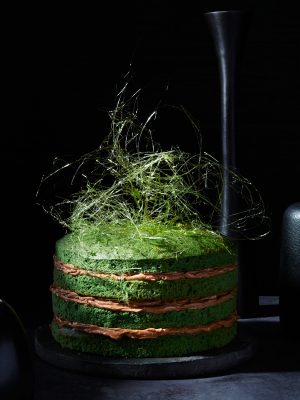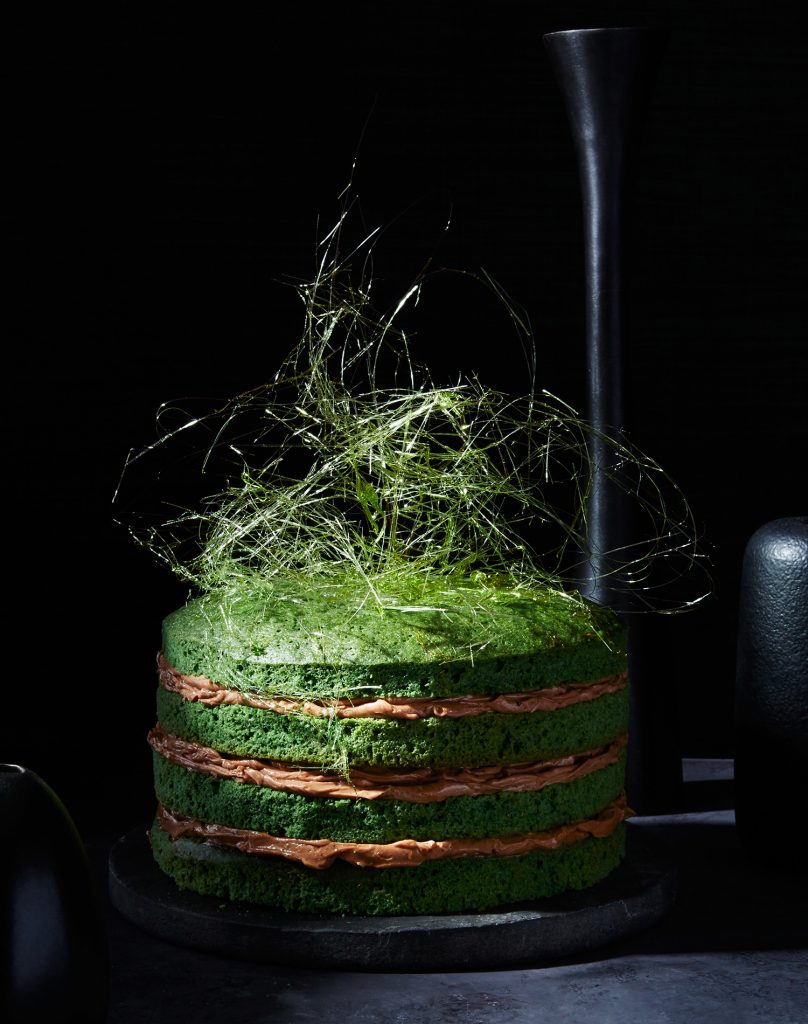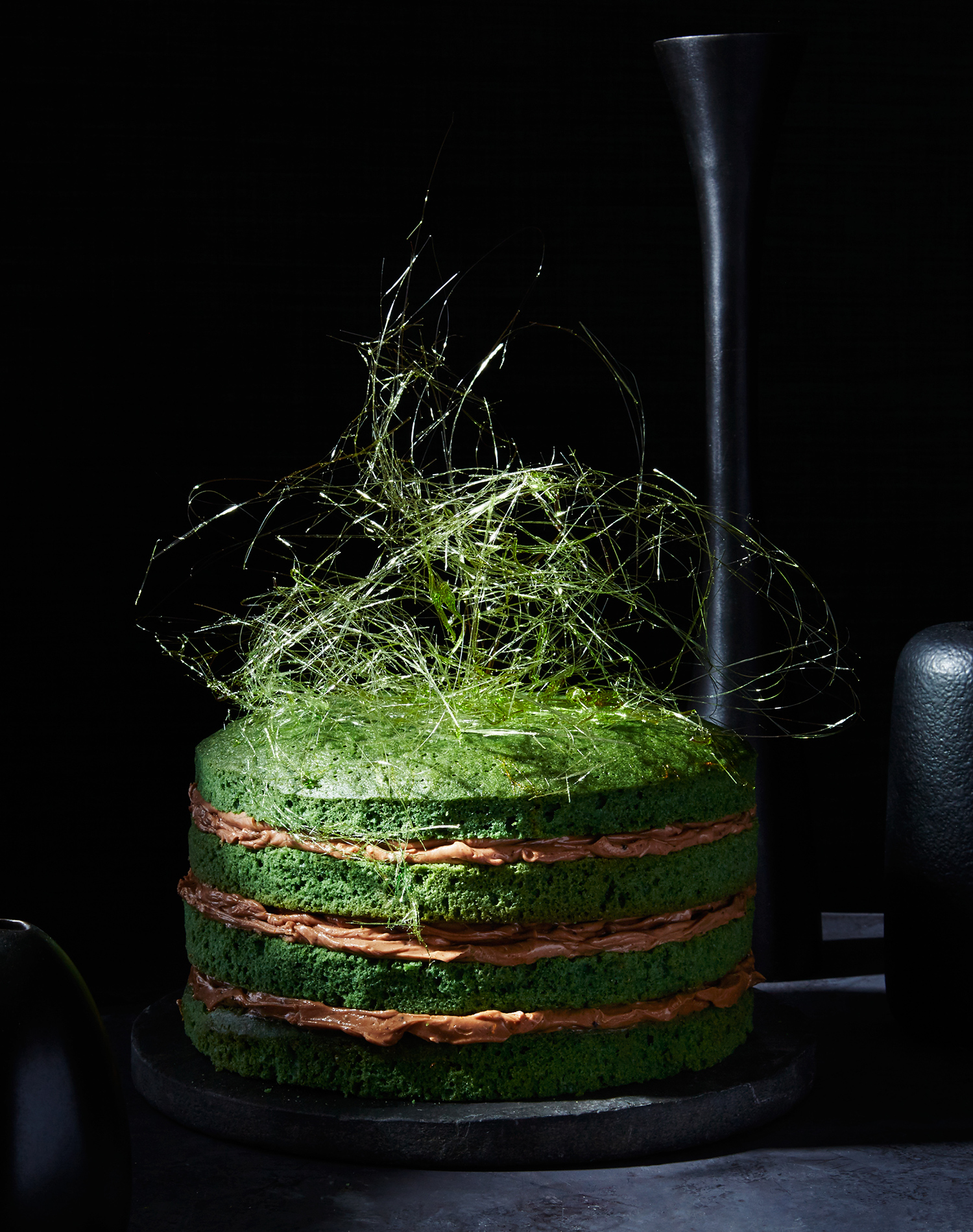Envy
Green with Envy Cake with Mocha Buttercream
Desserts from Issue 10 – Winter 2017 – Sin
Where the grass is actually greener.
Gather Journal Green with Envy Cake with Mocha Buttercream
Green with Envy Cake with Mocha Buttercream
Turning green with envy can be traced to the poet Sappho who used the color to describe the complexion of a forlorn lover (ancient medicine theorized that envy produced excess bile, giving skin a greenish cast). Years later, Shakespeare would tie the color to the vice in three of his works (Merchant of Venice, Antony and Cleopatra, and Othello), cementing its envious association. Our cake, cast a verdant hue by way of chlorophyll and spinach and stacked to statuesque proportions, is the idiom in dessert form.
makes 1, 4-layered (8-inch) cake
Green Cake
- 3¾ cups all-purpose flour
- 1 Tbsp baking powder
- 1¾ tsp salt
- 1¾ cups plus 2 Tbsp sugar
- 3 packed cups spinach leaves (3 oz)
- 1 cup plus 2 Tbsp olive oil
- 6 large eggs
- 1½ tsp liquid chlorophyll (available at Whole Foods or health food stores)
- ¾ tsp almond extract
Mocha Buttercream
- 1½ sticks (12 Tbsp) unsalted butter, softened
- 1½ cups powdered sugar
- 2 Tbsp unsweetened cocoa powder
- 1 Tbsp instant coffee
-
1
Preheat oven to 350°F. Grease 2 (8-inch) round cake pans and line with parchment paper, then grease paper.
-
2
Whisk together flour, baking powder, and salt in a medium bowl and set aside. Purée sugar, spinach, and oil in food processor until uniformly green. With machine running, add eggs one at a time, mixing completely after each. Pulse in chlorophyll and almond extract and transfer to a large bowl.
-
3
In two additions, stir and fold flour mixture into green mixture just until combined. Divide between cake pans. Rap pans a few times on counter to release trapped air. Bake until edges just pull away from sides and middle is set, 30 to 35 minutes. Cool cakes in pans on a rack 10 minutes, then remove from pans and cool completely.
-
4
While cake is baking, purée buttercream ingredients in food processor with pinch of salt until light and fluffy.
-
5
Trim sides of cake layers and tops to make flat layers. Use a long serrated knife to horizontally slice each cake in half. Place one layer on a platter and top with one third of buttercream, leaving sides unfrosted. Repeat with remaining layers and frosting, leaving the top bare. If the buttercream gets too soft, chill for a few minutes in the fridge.
-
6
Serve immediately or keep chilled up to 2 days.
Green Spun Sugar (optional)
Use caution. The sugar gets crazy hot and the process is not for the faint of heart.
Cover a wide swath of kitchen counter and floor with plastic trash bags. Drape the plastic so it extends down protecting cabinets as well. Set the handles of 2 to 3 large wooden spoons or wooden handled spatulas extending over the protected countertop and place a heavy cutting board on top to hold them in place. They can also be taped down. Cover that too. Just the dowel-like ends of the spoons should be protruding and exposed.
Cut the ends of a medium wire whisk with a wire cutter. You can also use forks but the cut whisk would be the ideal. Line a sheet pan with parchment and set that at the ready. Put a few inches of ice water in the sink. Locate your instant read thermometer.
Stir together 2 cups sugar, ⅔ cup water, and 2 Tbsp corn syrup in a medium saucepan. Bring to a boil over medium-high heat without stirring. Cover and simmer just until sugar crystals are dissolved, about 3 minutes. Uncover and check for any sugar crystals on sides of the pan. If so, dip a pastry brush in cold water and wash down any flecks into the pan to keep sugar from crystalizing. Cook, uncovered, until mixture reaches 293°F, about 5 to 6 minutes longer. Remove from heat and place bottom of pan in the ice water for 5 seconds. If you want the sugar colored, swirl in a few drops of food color (we went green).
Dip the whisk into caramel and carefully swing the whisk back and forth over the spoon handles carefully sending threads of sugar arcing over. The sugar should almost solidify in the air. Repeat until you have a cluster then lift off the spoons and form an extravagance. Transfer to the sheet pan and continue, reheating sugar if necessary, until you are satisfied or your arm is tired.
Spun sugar should be used immediately or kept several hours in an airtight container with silica packets.
To clean up, add water to pot along with the tools and boil until the sugar dissolves.

